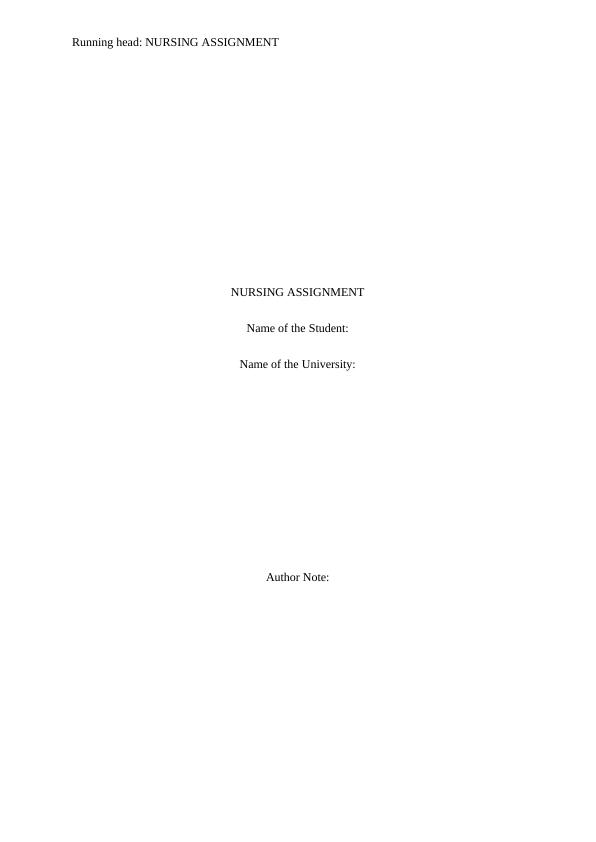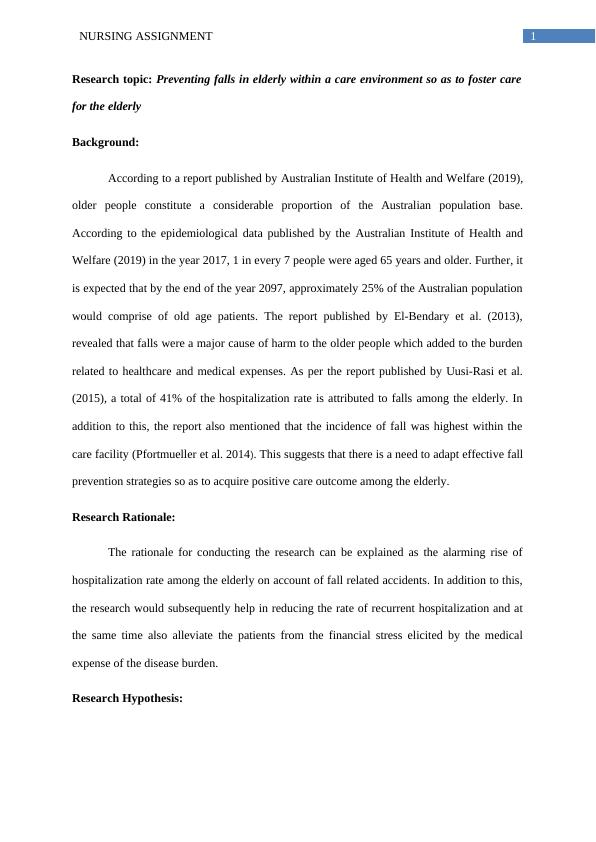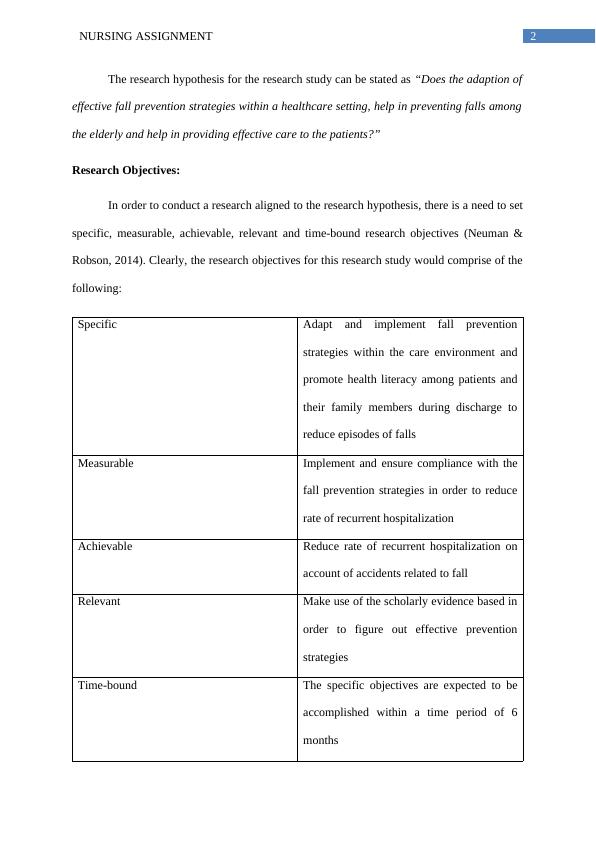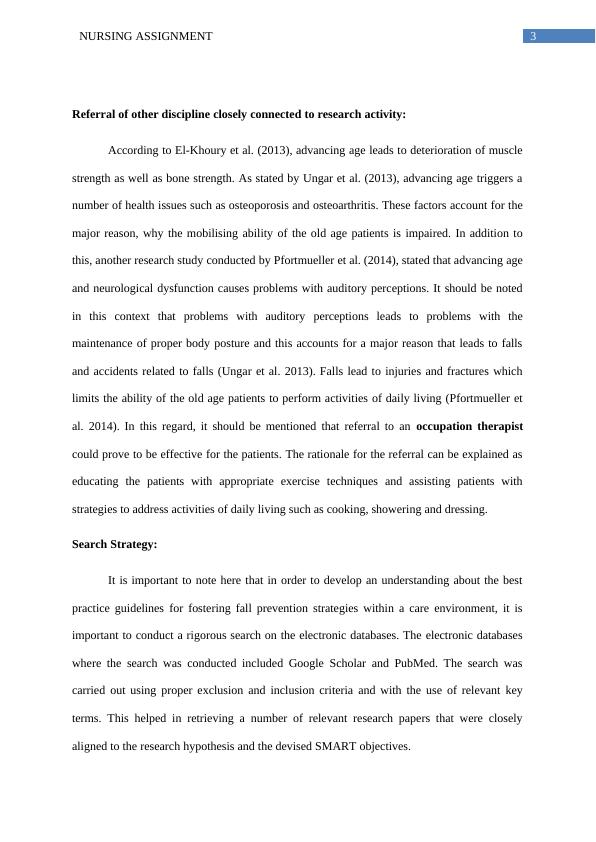Preventing Falls in Elderly: Effective Strategies for Care Environment
Added on 2023-01-23
21 Pages6072 Words62 Views
Running head: NURSING ASSIGNMENT
NURSING ASSIGNMENT
Name of the Student:
Name of the University:
Author Note:
NURSING ASSIGNMENT
Name of the Student:
Name of the University:
Author Note:

1NURSING ASSIGNMENT
Research topic: Preventing falls in elderly within a care environment so as to foster care
for the elderly
Background:
According to a report published by Australian Institute of Health and Welfare (2019),
older people constitute a considerable proportion of the Australian population base.
According to the epidemiological data published by the Australian Institute of Health and
Welfare (2019) in the year 2017, 1 in every 7 people were aged 65 years and older. Further, it
is expected that by the end of the year 2097, approximately 25% of the Australian population
would comprise of old age patients. The report published by El-Bendary et al. (2013),
revealed that falls were a major cause of harm to the older people which added to the burden
related to healthcare and medical expenses. As per the report published by Uusi-Rasi et al.
(2015), a total of 41% of the hospitalization rate is attributed to falls among the elderly. In
addition to this, the report also mentioned that the incidence of fall was highest within the
care facility (Pfortmueller et al. 2014). This suggests that there is a need to adapt effective fall
prevention strategies so as to acquire positive care outcome among the elderly.
Research Rationale:
The rationale for conducting the research can be explained as the alarming rise of
hospitalization rate among the elderly on account of fall related accidents. In addition to this,
the research would subsequently help in reducing the rate of recurrent hospitalization and at
the same time also alleviate the patients from the financial stress elicited by the medical
expense of the disease burden.
Research Hypothesis:
Research topic: Preventing falls in elderly within a care environment so as to foster care
for the elderly
Background:
According to a report published by Australian Institute of Health and Welfare (2019),
older people constitute a considerable proportion of the Australian population base.
According to the epidemiological data published by the Australian Institute of Health and
Welfare (2019) in the year 2017, 1 in every 7 people were aged 65 years and older. Further, it
is expected that by the end of the year 2097, approximately 25% of the Australian population
would comprise of old age patients. The report published by El-Bendary et al. (2013),
revealed that falls were a major cause of harm to the older people which added to the burden
related to healthcare and medical expenses. As per the report published by Uusi-Rasi et al.
(2015), a total of 41% of the hospitalization rate is attributed to falls among the elderly. In
addition to this, the report also mentioned that the incidence of fall was highest within the
care facility (Pfortmueller et al. 2014). This suggests that there is a need to adapt effective fall
prevention strategies so as to acquire positive care outcome among the elderly.
Research Rationale:
The rationale for conducting the research can be explained as the alarming rise of
hospitalization rate among the elderly on account of fall related accidents. In addition to this,
the research would subsequently help in reducing the rate of recurrent hospitalization and at
the same time also alleviate the patients from the financial stress elicited by the medical
expense of the disease burden.
Research Hypothesis:

2NURSING ASSIGNMENT
The research hypothesis for the research study can be stated as “Does the adaption of
effective fall prevention strategies within a healthcare setting, help in preventing falls among
the elderly and help in providing effective care to the patients?”
Research Objectives:
In order to conduct a research aligned to the research hypothesis, there is a need to set
specific, measurable, achievable, relevant and time-bound research objectives (Neuman &
Robson, 2014). Clearly, the research objectives for this research study would comprise of the
following:
Specific Adapt and implement fall prevention
strategies within the care environment and
promote health literacy among patients and
their family members during discharge to
reduce episodes of falls
Measurable Implement and ensure compliance with the
fall prevention strategies in order to reduce
rate of recurrent hospitalization
Achievable Reduce rate of recurrent hospitalization on
account of accidents related to fall
Relevant Make use of the scholarly evidence based in
order to figure out effective prevention
strategies
Time-bound The specific objectives are expected to be
accomplished within a time period of 6
months
The research hypothesis for the research study can be stated as “Does the adaption of
effective fall prevention strategies within a healthcare setting, help in preventing falls among
the elderly and help in providing effective care to the patients?”
Research Objectives:
In order to conduct a research aligned to the research hypothesis, there is a need to set
specific, measurable, achievable, relevant and time-bound research objectives (Neuman &
Robson, 2014). Clearly, the research objectives for this research study would comprise of the
following:
Specific Adapt and implement fall prevention
strategies within the care environment and
promote health literacy among patients and
their family members during discharge to
reduce episodes of falls
Measurable Implement and ensure compliance with the
fall prevention strategies in order to reduce
rate of recurrent hospitalization
Achievable Reduce rate of recurrent hospitalization on
account of accidents related to fall
Relevant Make use of the scholarly evidence based in
order to figure out effective prevention
strategies
Time-bound The specific objectives are expected to be
accomplished within a time period of 6
months

3NURSING ASSIGNMENT
Referral of other discipline closely connected to research activity:
According to El-Khoury et al. (2013), advancing age leads to deterioration of muscle
strength as well as bone strength. As stated by Ungar et al. (2013), advancing age triggers a
number of health issues such as osteoporosis and osteoarthritis. These factors account for the
major reason, why the mobilising ability of the old age patients is impaired. In addition to
this, another research study conducted by Pfortmueller et al. (2014), stated that advancing age
and neurological dysfunction causes problems with auditory perceptions. It should be noted
in this context that problems with auditory perceptions leads to problems with the
maintenance of proper body posture and this accounts for a major reason that leads to falls
and accidents related to falls (Ungar et al. 2013). Falls lead to injuries and fractures which
limits the ability of the old age patients to perform activities of daily living (Pfortmueller et
al. 2014). In this regard, it should be mentioned that referral to an occupation therapist
could prove to be effective for the patients. The rationale for the referral can be explained as
educating the patients with appropriate exercise techniques and assisting patients with
strategies to address activities of daily living such as cooking, showering and dressing.
Search Strategy:
It is important to note here that in order to develop an understanding about the best
practice guidelines for fostering fall prevention strategies within a care environment, it is
important to conduct a rigorous search on the electronic databases. The electronic databases
where the search was conducted included Google Scholar and PubMed. The search was
carried out using proper exclusion and inclusion criteria and with the use of relevant key
terms. This helped in retrieving a number of relevant research papers that were closely
aligned to the research hypothesis and the devised SMART objectives.
Referral of other discipline closely connected to research activity:
According to El-Khoury et al. (2013), advancing age leads to deterioration of muscle
strength as well as bone strength. As stated by Ungar et al. (2013), advancing age triggers a
number of health issues such as osteoporosis and osteoarthritis. These factors account for the
major reason, why the mobilising ability of the old age patients is impaired. In addition to
this, another research study conducted by Pfortmueller et al. (2014), stated that advancing age
and neurological dysfunction causes problems with auditory perceptions. It should be noted
in this context that problems with auditory perceptions leads to problems with the
maintenance of proper body posture and this accounts for a major reason that leads to falls
and accidents related to falls (Ungar et al. 2013). Falls lead to injuries and fractures which
limits the ability of the old age patients to perform activities of daily living (Pfortmueller et
al. 2014). In this regard, it should be mentioned that referral to an occupation therapist
could prove to be effective for the patients. The rationale for the referral can be explained as
educating the patients with appropriate exercise techniques and assisting patients with
strategies to address activities of daily living such as cooking, showering and dressing.
Search Strategy:
It is important to note here that in order to develop an understanding about the best
practice guidelines for fostering fall prevention strategies within a care environment, it is
important to conduct a rigorous search on the electronic databases. The electronic databases
where the search was conducted included Google Scholar and PubMed. The search was
carried out using proper exclusion and inclusion criteria and with the use of relevant key
terms. This helped in retrieving a number of relevant research papers that were closely
aligned to the research hypothesis and the devised SMART objectives.

4NURSING ASSIGNMENT
Resource Links:
Karlsson, M. K., Magnusson, H., von Schewelov, T., & Rosengren, B. E. (2013). Prevention
of falls in the elderly—a review. Osteoporosis international, 24(3), 747-762. Retrieved from:
https://www.ncbi.nlm.nih.gov/pubmed/23296743
Miake-Lye, I. M., Hempel, S., Ganz, D. A., & Shekelle, P. G. (2013). Inpatient fall
prevention programs as a patient safety strategy: a systematic review. Annals of internal
medicine, 158(5_Part_2), 390-396. Retrieved from:
https://www.ncbi.nlm.nih.gov/pubmed/23460095
Methodology:
In order to conduct the research study, the research methodology that would be
adapted would comprise of conducting a literature review of the available scholarly
literatures. As stated by Neuman and Robson (2014), conducting an elaborate review of the
existing scholarly literatures helps in developing an understanding about the best practice
strategies that has been implemented in order to acquire positive outcome. The review of the
literature would be conducted by scanning the electronic databases and by using relevant key
terms. After conducting a thorough review of the literatures, a systematic review would be
conducted of the recruited scholarly literatures. The rationale for the choice of the methods
can be explained as better feasibility of addressing the research topic within a stipulated
period of time. In addition to this, building on the evidence base would also equip the
researcher with an elaborate idea about the research developments and accordingly help the
researcher in identifying existing research gaps which needs to be bridged in order to promote
positive patient outcome.
Data Collection and evaluation process:
Resource Links:
Karlsson, M. K., Magnusson, H., von Schewelov, T., & Rosengren, B. E. (2013). Prevention
of falls in the elderly—a review. Osteoporosis international, 24(3), 747-762. Retrieved from:
https://www.ncbi.nlm.nih.gov/pubmed/23296743
Miake-Lye, I. M., Hempel, S., Ganz, D. A., & Shekelle, P. G. (2013). Inpatient fall
prevention programs as a patient safety strategy: a systematic review. Annals of internal
medicine, 158(5_Part_2), 390-396. Retrieved from:
https://www.ncbi.nlm.nih.gov/pubmed/23460095
Methodology:
In order to conduct the research study, the research methodology that would be
adapted would comprise of conducting a literature review of the available scholarly
literatures. As stated by Neuman and Robson (2014), conducting an elaborate review of the
existing scholarly literatures helps in developing an understanding about the best practice
strategies that has been implemented in order to acquire positive outcome. The review of the
literature would be conducted by scanning the electronic databases and by using relevant key
terms. After conducting a thorough review of the literatures, a systematic review would be
conducted of the recruited scholarly literatures. The rationale for the choice of the methods
can be explained as better feasibility of addressing the research topic within a stipulated
period of time. In addition to this, building on the evidence base would also equip the
researcher with an elaborate idea about the research developments and accordingly help the
researcher in identifying existing research gaps which needs to be bridged in order to promote
positive patient outcome.
Data Collection and evaluation process:

5NURSING ASSIGNMENT
A research study conducted by Karlsson et al. (2013), mentioned that the frequency of
fall and fall related accidents among the older adults increased with the advancing age. Falls
result in soft tissue injuries as well as pain, functional impairment and decreased quality of
life among the senior adults. Karlsson et al. (2013) conducted a review of the randomized
control trials that have successfully implemented fall prevention strategies in order to reduce
the incidences of fall among the elderly in a healthcare setting. The researchers typically
identified that regular physical training program for the elderly as well as modification of the
high-risk environment helped in promoting an effective patient outcome. In addition to this,
increased consumption of vitamin D supplements and using anti-slip shoe devices while
walking on tiled floors also helped in the reduction of the episodes of fall. As stated by
Miake-Lye et al. (2013), the rate of falls within acute care units ranges in between 1 to 9
patients per 1000 bed days. The researchers concluded on the basis of an exhaustive
systematic review that the use of multicomponent interventions could help in the reduction of
fall episodes among the old age patients (Miake-Lye et al.,2013). The multicomponent
intervention strategies made use of components such as conducting risk assessment for the
patients, imparting health literacy to the care professionals as well as the patients and
teaching patients about bedside signs, wristband alerts in order to ensure prevention from
falls (Miake-Lye et al., 2013). In addition to the researchers also stressed upon the
appropriate footwear recommendation, medication review as well as offering supervision
with toileting and washing in order to reduce the incidences of fall among the acute care unit
(Miake-Lye et al., 2013). The research study indicated that the implementation of the
recommended strategies within a healthcare setting helped in reducing the episodes of fall
among the elderly. Barker et al. (2016), conducted a randomised control trial across six
Australian hospitals in order to test the effectiveness of a 6 PACK program to reduce the
incidences of fall within the hospital setting. The 6 PACK program was basically a support
A research study conducted by Karlsson et al. (2013), mentioned that the frequency of
fall and fall related accidents among the older adults increased with the advancing age. Falls
result in soft tissue injuries as well as pain, functional impairment and decreased quality of
life among the senior adults. Karlsson et al. (2013) conducted a review of the randomized
control trials that have successfully implemented fall prevention strategies in order to reduce
the incidences of fall among the elderly in a healthcare setting. The researchers typically
identified that regular physical training program for the elderly as well as modification of the
high-risk environment helped in promoting an effective patient outcome. In addition to this,
increased consumption of vitamin D supplements and using anti-slip shoe devices while
walking on tiled floors also helped in the reduction of the episodes of fall. As stated by
Miake-Lye et al. (2013), the rate of falls within acute care units ranges in between 1 to 9
patients per 1000 bed days. The researchers concluded on the basis of an exhaustive
systematic review that the use of multicomponent interventions could help in the reduction of
fall episodes among the old age patients (Miake-Lye et al.,2013). The multicomponent
intervention strategies made use of components such as conducting risk assessment for the
patients, imparting health literacy to the care professionals as well as the patients and
teaching patients about bedside signs, wristband alerts in order to ensure prevention from
falls (Miake-Lye et al., 2013). In addition to the researchers also stressed upon the
appropriate footwear recommendation, medication review as well as offering supervision
with toileting and washing in order to reduce the incidences of fall among the acute care unit
(Miake-Lye et al., 2013). The research study indicated that the implementation of the
recommended strategies within a healthcare setting helped in reducing the episodes of fall
among the elderly. Barker et al. (2016), conducted a randomised control trial across six
Australian hospitals in order to test the effectiveness of a 6 PACK program to reduce the
incidences of fall within the hospital setting. The 6 PACK program was basically a support

End of preview
Want to access all the pages? Upload your documents or become a member.
Related Documents
Stopping Elderly Accidents, Deaths and Injurieslg...
|7
|1685
|44
Nursing Education Plan for Fall Prevention Among Elderlylg...
|6
|645
|35
Nursing Assessment Report | Nursing Qualitylg...
|13
|3478
|19
Clinical Practice Improvement Project Report on Accidental Fall Prevention among Older Adultslg...
|9
|2850
|417
Prevention of Fall in Elderly: Training and Learning Methods for Geriatric Care Professionalslg...
|15
|1192
|365
Interventions to Prevent Fall Injury in Older Clientslg...
|5
|1055
|100
